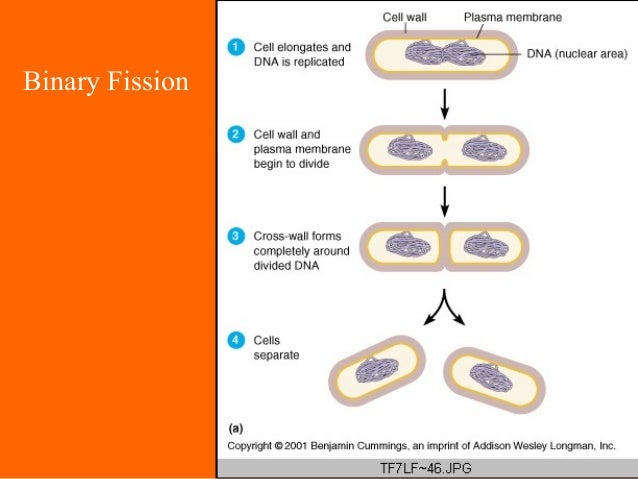

During the exponential growth phase (log phase) the population increases geometrically as long as there is sufficient food and space for growth.During the lag phase growth is relatively flat and the population appears either not to be growing or growing quite slowly as newly inoculated cells are adapt to their new environment.In a closed growth system, a bacterial population usually exhibits a predictable pattern of growth - its growth curve - that follows several stages or phases.

Although bacteria are capable of replicating geometrically as a result of binary fission, this only occurs as long as their is space to grow, sufficient nutrients, and a way to dispose of waste products.The bacterial divisome is responsible for directing the synthesis of new cytoplasmic membrane and new peptidoglycan to form the division septum.Par proteins function to separate bacterial chromosomes to opposite poles of the cell during bacterial cell division.Because of binary fission, bacteria increase their numbers by geometric progression whereby their population doubles every generation time.For many bacteria the generation time ranges from minutes to hours. Generation time is the time it takes for a population of bacteria to double in number.Bacteria replicate by binary fission, a process by which one bacterium splits into two.Oblique Binary fission - This type of binary fission is seen in protozoans such as dinoflagellates. Here the fission occurs in a plane oblique to the body of the organism.\)), although the rate of death depends on the degree of toxicity and the resistance of the species and viable cells may remain for weeks to months.Here the fission occurs in a plane right angle to the of the body of the organism. Transverse binary fission: This type of binary fission is seen in ciliated protozoans.Here the fission occurs in a plane parallel to the longitudinal axis of the body of the organism. Longitudinal binary fission: This type of binary fission is seen in protozoans belonging to the class Mastigophora.Here the body divides into two parts without any defined plane of fission. Irregular Binary fission: This type of binary fission is seen in protozoans with irregular body forms.On the basis of the plane of division binary fission in protozoa is of the following types: Binary fission is seen in Single-celled organisms like protozoa.Under this, an organism duplicates its genetic material, and then divides into two parts (cytokinesis), with each new organism receiving one copy of DNA.It is asexual reproduction by a separation of the body into two new bodies.Both Bacteria & Protozoa reproduce asexually by Binary fission but in the Official answer key the examiner has considered Protozoa as the correct answer.Budding, Plasmotomy, vegetative propagation, Apomixis & Parthenogenesis Asexual reproduction is of many types: Sporulation, Fission, Fragmentation.The offsprings are exact replica of their parents and genetically identical.The reproduction in which an offspring is produced by a single parent without the fusion of gametes is called asexual reproduction.The offsprings show characteristics of both male and female parents and show variation.It is an elaborate, complex, and slow process as compared to asexual reproduction.These gametes fuse to form the zygote which develops to form the new organism.Involves the formation of the male and female gametes, either by the same individual or by different individuals of the opposite sex.Reproduction is mainly divided into two types:.It is responsible for the continuity of species generation after generation.Reproduction is the biological process in which the organism gives rise to young ones or offsprings similar to itself.


 0 kommentar(er)
0 kommentar(er)
